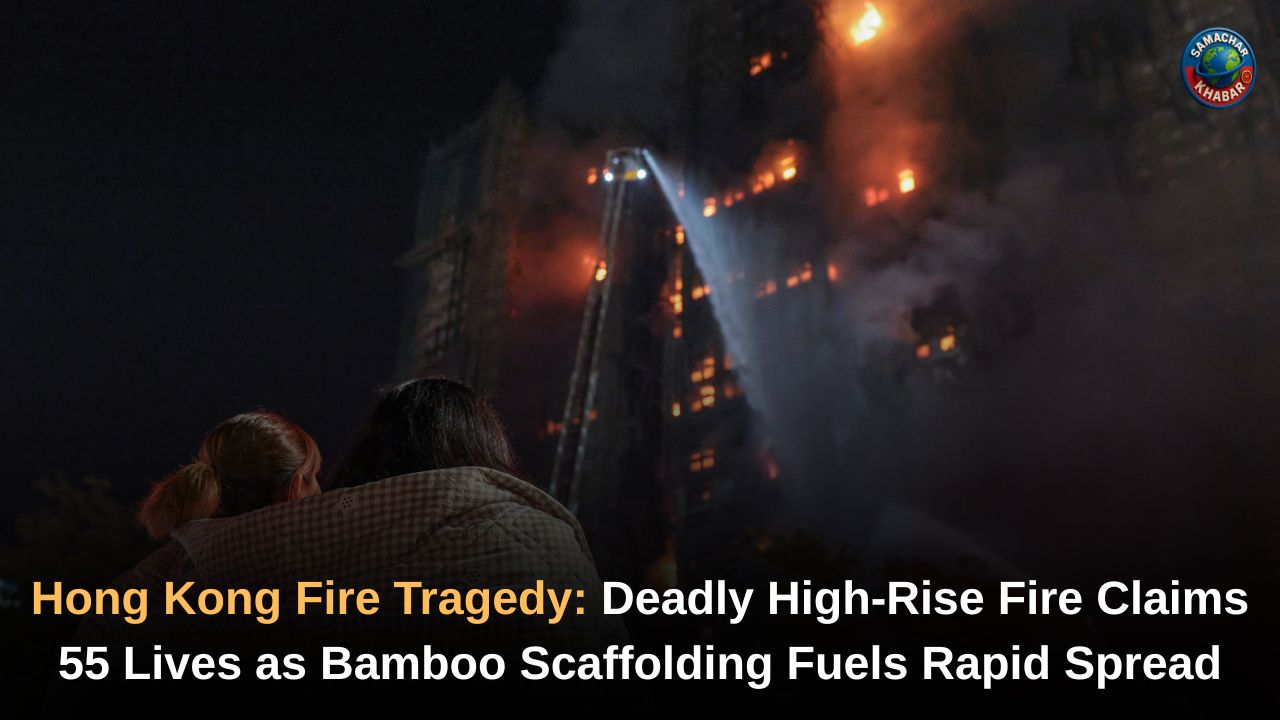Hong Kong witnessed one of its darkest days as a catastrophic fire tore through the Wang Fuk Court housing estate in Tai Po, killing at least 55 people and leaving more than 279 missing. The blaze, which erupted on Wednesday afternoon, rapidly consumed seven of the estate’s eight high-rise towers—each sheathed in bamboo scaffolding and flammable netting due to ongoing renovations.
Firefighters battled extreme heat, falling debris, and blocked access points as the inferno surged upward. Authorities have launched criminal investigations, arrested multiple construction officials, and suspended election campaigning as the city reels from its worst fire in seven decades.
Key Takeaways on the Hong Kong High-Rise Fire Disaster
- At least 55 people, including a firefighter, were confirmed dead as flames ripped through seven high-rise towers.
- More than 279 residents remain missing, with hundreds still feared trapped inside upper floors.
- Highly flammable bamboo scaffolding, green netting, and styrofoam materials used in renovations accelerated the fire’s spread.
- Three construction company officials were arrested for gross negligence and suspected manslaughter.
- Over 900 people moved to temporary shelters as rescue operations continue.
- Hong Kong’s leader orders citywide inspections of all housing estates under renovation.
- This is Hong Kong’s deadliest fire in more than 70 years.
Seven Towers Engulfed: How the Disaster Unfolded
The tragedy began at 2:51 PM local time on Wednesday when emergency services received the first call from Wang Cheong House, one of the eight towers in Wang Fuk Court. The residential block, standing 31 storeys tall, was fully wrapped in bamboo scaffolding, green protective netting, and renovation materials. Within minutes, locals reported that the scaffolding itself had caught fire.
Fire department deputy director Derek Armstrong Chan explained that by the time crews arrived, “the scaffolding was on fire,” and within moments the flames had leapt from one block to another. Witness videos showed the bamboo igniting like matchsticks, sending spirals of fire across the façade of multiple towers.
Within the first hour, seven of the eight buildings were ablaze.
Extreme Heat and Falling Debris Blocked Rescue Efforts
Firefighters reached the site within five minutes, but the situation was already spiraling out of control. The towers trapped intense heat, making upper-floor access nearly impossible. Chan described temperatures as “extremely high,” preventing crews from pushing upward to reach crying residents who had called for help.
A day later, apartments were still burning, and dense black smoke filled the Tai Po skyline. Fire crews battled collapsing scaffolding, burning debris drifting through the air, and dangerously unstable structures.
A 37-year-old firefighter, Ho Wai-ho, lost his life after becoming separated from his team for half an hour. Two more firefighters were injured—one suffering a leg injury, the other severe exhaustion.
Residents Trapped, Alarms Silent, and Windows Sealed Shut
Survivors reported an alarming detail—no fire alarms were heard inside many towers. Residents relied on banging doors, ringing bells, and shouting warnings from apartment to apartment.
The buildings were under renovation, and many windows had been sealed with styrofoam boards. Authorities later revealed that these flammable boards—used on every floor—helped flames travel rapidly through lift lobbies and corridors.
Some residents couldn’t even see the fire because they had kept windows closed due to dust from construction. A 65-year-old resident named Yuen said neighbors had to call each other because “some people didn’t know there was a fire.”
Hundreds fled barefoot, confused, and empty-handed.
Criminal Investigation and Arrests: Unsafe Materials Blamed
Hong Kong police wasted no time launching a criminal probe. Early Thursday, three men—including two directors and a consultant from the construction company—were arrested for manslaughter and gross negligence.
Officers confirmed:
- Protective netting and plastic sheeting did not meet fire safety standards.
- Styrofoam used to seal windows was highly flammable.
- Foam and waste materials were left scattered around the towers.
Investigators searched the company’s premises and seized binders of documents for forensic review. Authorities also began examining other major public housing sites across the city.
Scenes of Panic: Survivors Describe Horror
Residents told harrowing stories as they watched their homes crumble into flames.
Shirley Chan described the devastation: “Imagine a home—gone, burnt. It is truly heartbreaking.”
Jason Kong, a resident trapped on an upper floor, told Reuters he was “devastated” and unsure whether many of his neighbors had survived.
A Tai Po resident surnamed So could only watch helplessly. “We can only hope everyone can return safely,” he said.
More than 900 residents have moved into temporary shelters. Police officers at the shelters struggled to count the missing as people continued arriving throughout the night to report relatives unaccounted for.
Government, Global Leaders React
Hong Kong Chief Executive John Lee suspended election campaigning and said the government is dedicating “all its manpower and efforts” to rescue operations. He also ordered urgent inspections of all housing estates currently under renovation citywide.
Chinese President Xi Jinping offered condolences and urged authorities to make “every effort” to minimize casualties. Leaders from Japan, Germany, Canada, the UK, and Taiwan also extended sympathy to Hong Kong.
Why Bamboo Scaffolding Played a Deadly Role
Bamboo scaffolding is deeply rooted in Hong Kong’s construction culture, admired for its flexibility and lightweight structure. But it is also highly combustible.
Authorities had already been planning to phase it out, especially after acknowledging multiple fatal accidents involving bamboo scaffolders in recent years. In Wednesday’s fire:
- The bamboo acted as fuel
- Wind spread burning debris between towers
- Green netting trapped heat and flames
- Styrofoam boards ignited rapidly
The combination turned the entire complex into a vertical firestorm.
A Defining Look at a Disaster That Shook Hong Kong
The Wang Fuk Court fire is now recognized as Hong Kong’s worst blaze in over 70 years surpassing the 1996 Garley Building fire that killed 41. As search efforts continue and the death toll is expected to rise, Hong Kong faces urgent questions about safety oversight, renovation practices, materials used during construction, and the aging infrastructure of its massive public housing system.
Authorities have promised accountability, structural safety inspections, and support for victims who have lost families, pets, and lifelong homes in minutes. The city now stands at a critical juncture, confronting the vulnerabilities exposed by this unprecedented tragedy.
FAQs on the Hong Kong High-Rise Fire Tragedy
1. What caused the Hong Kong high-rise fire at Wang Fuk Court?
The fire spread rapidly due to bamboo scaffolding, flammable green netting, and styrofoam boards used during renovations, though the exact ignition source is still under investigation.
2. How many people died in the Hong Kong high-rise fire?
At least 55 people, including a firefighter, died in the blaze that swept through seven high-rise towers undergoing renovation.
3. How many residents are still missing after the Hong Kong fire?
Authorities reported more than 279 residents unaccounted for, with rescue teams still searching upper floors of the affected towers.
4. Why were construction officials arrested after the fire?
Three construction company officials were arrested for manslaughter after investigators found unsafe scaffolding materials and flammable styrofoam used on the buildings.
5. What actions has the Hong Kong government taken after the fire?
The government launched a criminal investigation, ordered inspections of all public housing estates under renovation, and opened shelters for more than 900 displaced residents.
















